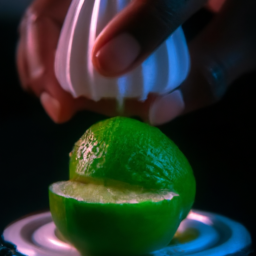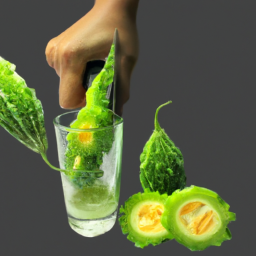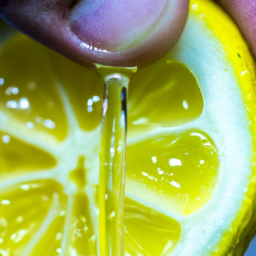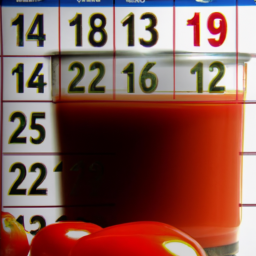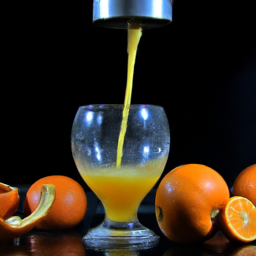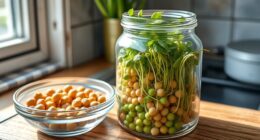Juicing key limes may appear difficult for beginners, but there’s no need to fret. Allow me, an experienced juicer, to guide you smoothly through the process of extracting juice from a key lime.
In this article, I will share with you my tips and tricks on how to select the right key limes, prepare them, and use a juicer or reamer to extract the juice efficiently.
First and foremost, let’s gather the necessary tools for juicing. You will need a sharp knife, a cutting board, a juicer or reamer, and a container to collect the juice.
It’s also essential to select fresh and ripe key limes to ensure the best flavor and yield. With these tools and ingredients at hand, you’ll be able to produce delicious key lime juice that can be used in various recipes or enjoyed on its own.
So let’s get started!
Key Takeaways
- Use fresh, ripe, and thin-skinned key limes for the best flavor and yield
- Use a sharp knife, juicer or reamer, and container to collect the juice
- Strain the juice using a fine mesh strainer or cheesecloth
- Key lime juice can be used as a marinade, in salad dressings, desserts, and cocktails
Gather Your Tools
Gather your tools!
You’re gonna need some tools, so grab ’em and get ready to conquer that juicy key lime! First things first, you’ll need a juicer. If you don’t have one, don’t worry! There are plenty of alternatives that will work just as well. A fork, a citrus reamer, or even your bare hands can do the trick. Just make sure to wash your hands thoroughly beforehand.
Once you have your juicing tool of choice, it’s important to make sure it’s clean. Any dirt or debris on your juicer can taint the flavor of your lime juice. So, give it a good rinse with warm water and soap before using it.
Finding alternatives and cleaning your tools may seem like minor steps, but they make a big difference in the outcome of your juice. With your tools cleaned and ready, let’s move on to selecting the right key limes.
Selecting the Right Key Limes
When it comes to selecting the right key limes for juicing, I always make sure to look for ripe limes with thin skin.
Ripe limes have a softer texture and yield more juice compared to unripe ones. Thin-skinned limes are easier to juice and have a more concentrated flavor.
By keeping these tips in mind, you can ensure that you’re getting the best quality limes for your juice.
Look for Ripe Limes
To get the best juice, it’s important to pick key limes that feel soft and have a slight give when squeezed. Identifying ripeness is crucial because unripe key limes have less juice and a bitter taste.
Here are some tips for choosing ripe key limes:
-
Look for limes that are yellow-green in color. They should not be completely green or yellow.
-
Check for small brown spots on the skin. These indicate that the lime is ripe and flavorful.
-
Smell the lime. A ripe key lime should have a strong aroma that is characteristic of the key lime flavor profile.
Once you have selected ripe key limes, the next step is to choose limes with thin skin. This will make it easier to extract the juice and get the most out of each lime.
Choose Limes with Thin Skin
If you want the most flavor in your lime-based dishes, opt for limes with thin skin. Selecting ripe key limes with thin skin is crucial for juicing.
When shopping for limes, avoid thick-skinned ones as they tend to be drier and contain less juice. Thin-skinned limes, on the other hand, are more plump, juicy, and burst with tangy flavor.
Thin-skinned limes are easier to juice and have a higher juice yield. When squeezing the juice out of the lime, it takes less effort to extract the juice from the thin-skinned limes. Additionally, thin-skinned limes tend to be less bitter and more acidic, making them perfect for using in cocktails, marinades, and dressings.
Now that you have selected the perfect limes, let’s move on to preparing them for juicing.
Preparing the Limes
First, you’ll need to select small, firm key limes that are bright green in color for the best flavor and juicing results. Once you have your limes, it’s time to prepare them for juicing.
Start by washing the limes thoroughly under running water to remove any dirt or debris. Afterward, dry them off with a clean towel.
Next, use a sharp knife to cut off both ends of the lime. Then, cut the lime in half lengthwise. You can either juice the lime as is or use a citrus reamer to extract the juice.
If you choose to juice the lime as is, make sure to hold it over a bowl to catch any juice that may spill out. Once you have extracted all the juice, you can move on to using a juicer.
Using a Juicer
After selecting small, firm, and bright green limes, the next step in preparing them for optimal juicing is to use a high-quality juicer. Juicers are efficient and can extract a large amount of juice from the limes in a short amount of time. Here are some citrus juicing techniques to ensure that you get the most out of your key limes:
-
Cut the limes in half: Use a sharp knife to cut the key limes in half. This will make it easier for the juicer to extract the juice.
-
Place the limes in the juicer: Make sure that the cut side of the lime is facing down in the juicer. This will help to maximize the amount of juice that is extracted.
-
Use the juicer on high speed: Most juicers have multiple speed settings. It’s best to use the high-speed setting to extract the most juice from the limes.
Using a juicer is a quick and efficient way to extract juice from key limes. However, if you don’t have a juicer, you can also use a reamer to manually extract the juice.
Using a Reamer
When using a reamer, you’ll want to press the fruit firmly against the pointed end and twist it back and forth until all the delicious, tangy liquid has been extracted. The technique requires a bit of elbow grease, but it’s worth it for the fresh, homemade flavor of key lime juice.
There are a few different citrus reamer varieties available, but I find that a wooden reamer works best for key limes. It’s gentle on the delicate flesh and allows you to extract every last drop of juice.
Other juicing techniques, such as using a juicer or squeezing the fruit by hand, can work well too, but I prefer the control and precision that a reamer provides.
Once you’ve extracted the juice, the next step is to strain it to remove any seeds or pulp.
Straining the Juice
To fully savor the tangy flavor of your freshly squeezed key lime juice, it’s important to strain out any unwanted bits and pieces. There are several straining techniques you can use, depending on the juicing equipment you have available and the level of pulp you want in your juice.
One option is to use a fine mesh strainer or cheesecloth to catch any seeds or pulp as you pour the juice through. Another option is to use a juicer with a built-in strainer to separate the juice from the pulp automatically. Whichever method you choose, be sure to press down on the pulp to extract as much juice as possible before discarding it. Now that your juice is perfectly strained, it’s time to move on to the next step of storing it for future use.
Storing the Juice
You don’t want all your hard work to go to waste, so it’s important to know how to properly preserve this little piece of sunshine in a bottle for future use.
There are a few preservation methods you can use to keep your key lime juice fresh. One option is to store it in an airtight container in the refrigerator. This will keep it fresh for up to a week or two. You can also freeze the juice in ice cube trays and then transfer the frozen cubes to a freezer-safe bag or container. This will keep the juice fresh for up to six months.
When it comes to recipes, there are countless ways to use key lime juice. It’s a popular ingredient in pies, cocktails, and marinades. You can also use it to add a pop of flavor to dressings, sauces, and even grilled meats. Just be sure to adjust the amount of juice based on the recipe you’re using.
Now that you know how to store your key lime juice, let’s explore some alternative methods for juicing these tiny but mighty fruits.
Alternative Methods
Get ready to discover some new ways to extract the zesty, tangy goodness from those little green fruits that’ll have your taste buds dancing with excitement. Juicing without a juicer can be a bit daunting, but fear not, there are alternative methods that can be just as effective. Here are a few techniques I use to get the most out of my key limes:
-
Squeezing by hand: This method is simple and requires no special equipment. Cut the lime in half and hold it over a bowl, then use your hands to squeeze the juice out. Make sure to twist and turn the lime to get all the juice out.
-
Using a fork: This method is similar to squeezing by hand, but it can be a bit easier. Cut the lime in half and use a fork to pierce the flesh. Then, use the fork to twist and turn the lime while squeezing it over a bowl.
-
Using a citrus reamer: If you have one, a citrus reamer can be a great tool for juicing key limes. Cut the lime in half and place it cut-side down on the reamer. Twist and turn the reamer to extract the juice.
-
Using a blender: For a larger batch of juice, you can use a blender to extract the juice. Cut the limes into quarters and place them in the blender with a little water. Blend until smooth, then strain the mixture through a fine sieve or cheesecloth.
In addition to these techniques, there are also a variety of key lime juice recipes that can add even more complexity to your dishes. From key lime pie to margaritas, the possibilities are endless. Experiment with different recipes to find your favorite way to enjoy this delicious citrus fruit.
Now that you have some alternative methods for juicing key limes and some recipe ideas to try, let’s move on to some tips and tricks for getting the most out of your limes.
Tips and Tricks
Discover the secret to unlocking the full potential of this zesty citrus fruit with these expert tips and tricks. When it comes to juicing key limes, there are a few hacks that can make the process easier and more efficient. Firstly, roll the key lime on a hard surface before cutting it in half to help release more juice. Secondly, use a citrus reamer or a fork to extract the juice from the fruit, as this will help you get the most out of each key lime.
In addition to making juicing easier, there are also many benefits to consuming citrus juice. Key limes, in particular, are a great source of vitamin C, which can help boost your immune system. They also contain antioxidants that can help protect your cells from damage and reduce inflammation in your body. So, not only is juicing key limes a delicious way to add flavor to your drinks and meals, but it can also be a healthy addition to your diet. Now, let’s move on to the next section and find out how to enjoy your freshly juiced key limes.
Enjoying Your Freshly Juiced Key Limes
Savor the zesty and tangy flavor of freshly squeezed key limes in your favorite dishes and drinks by incorporating this versatile fruit into your recipes. Key lime juice is a wonderful addition to sweet and savory dishes alike.
You can use it as a marinade for meat and seafood, add it to salad dressings for a burst of flavor, or use it to make deliciously tart desserts like key lime pie. Get creative with your key lime juice and experiment with new recipes.
You can use it to make homemade key limeade, or add it to your favorite cocktails for a refreshing twist. Not only is key lime juice delicious, it also has many health benefits. It’s high in vitamin C, which can help boost your immune system, and it also contains antioxidants that can help protect against disease.
So go ahead and enjoy your freshly juiced key limes – your taste buds and your body will thank you!
Frequently Asked Questions
How many key limes are needed to make a glass of juice?
Do you want to know the secret to the perfect key lime juice ratio? It’s simple, just use 3-4 key limes per glass. The best way to extract the juice from key limes is to roll them before cutting and squeezing.
Can I substitute regular limes for key limes in a recipe?
Yes, you can substitute regular limes for key limes in a recipe. However, keep in mind that key lime flavor is distinct and may be lost with lime juice substitutes. Adjustments may need to be made to achieve the desired taste.
How long do key limes stay fresh once they are picked?
I once forgot about a bag of key limes in my fridge for two weeks. To prevent this, store key limes at room temperature and use within a week. For longer preservation, freeze the juice or zest.
Can I freeze key lime juice for later use?
Yes, you can freeze key lime juice for later use. It’s best to store it in an airtight container or freezer bag, and it will last up to 6 months. However, it’s important to note that the quality may diminish over time.
What are some common recipes that use fresh key lime juice?
As a fan of tart desserts, I adore adding fresh key lime juice to my Key lime pie recipe. But it’s not just for sweets- it also makes a fantastic addition to marinades for a tangy kick.
Conclusion
Juicing key limes is a simple and rewarding task that can add a burst of tangy flavor to any dish or drink. Whether you’re making a key lime pie or a refreshing margarita, fresh juice is key to achieving the perfect balance of sweet and sour.
With the right tools and techniques, juicing key limes can be a breeze. In a way, juicing key limes is like playing a musical instrument. It requires precision and practice to achieve the perfect tune. But once you master the art, the results are nothing short of magical.
So gather your tools, select the right key limes, and let the juicing begin. With a little patience and a lot of love, you’ll be savoring the taste of freshly juiced key limes in no time.
Ilana has been a vegan for over 10 years. She originally made the switch for health reasons, but soon found herself becoming more and more passionate about the ethical and environmental implications of a vegan lifestyle. Ilana is the author of The Graceful Kitchen, a blog all about veganism. She loves to cook up delicious and nutritious vegan meals, and share her recipes with others who are interested in leading a cruelty-free life. Ilana is also a strong advocate for using whole foods as the foundation of a healthy diet, and believes that going vegan is one of the best ways to achieve this.
